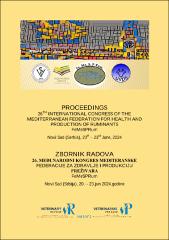| dc.contributor.author | Stanković, Branislav | |
| dc.contributor.author | Hristov, Slavča | |
| dc.contributor.author | Bugarski, Dejan | |
| dc.contributor.author | Ninković, Milan | |
| dc.contributor.author | Kureljušić, Branislav | |
| dc.contributor.author | Kjosevski, Miroslav | |
| dc.contributor.author | Chantziaras, Ilias | |
| dc.date.accessioned | 2024-07-10T09:00:22Z | |
| dc.date.available | 2024-07-10T09:00:22Z | |
| dc.date.issued | 2024-06-20 | |
| dc.identifier.isbn | 978-86-7520-611-8 | |
| dc.identifier.uri | https://repo.niv.ns.ac.rs/xmlui/handle/123456789/848 | |
| dc.description.abstract | Biosecurity is the result of all activities designed not only to prevent the introduction and spread of infectious diseases within and between herds, but ultimately to contribute to public health and food safety. Although experts and government agencies recommend the implementation of biosecurity practises on dairy, beef and sheep farms, their use appears to be limited. There is serious lack of training and consequently, rather low level of awareness of biosecurity risks among farmers. They are aware of necessity of good health of animals, but they mostly think of endemic diseases like mastitis, claws disorders, digestive problems, etc.). It seems that they are not aware of contagious disease risks, so pathogens models of spreading and entrance doors in to individual animal or population have to be pointed out. Farmers’ opinion is that the government should have a greater input into biosecurity; veterinarians saw the ability or willingness of their clients to invest in biosecurity measures as a major barrier. Therefore, additional evidence of the effectiveness and/or potential economic benefits of proposed on-farm biosecurity measures have be better demonstrated. That would give a solid base for field veterinarians and their organisations to be more proactive in promotion and spreading of information on biosecurity, in both direct contact with farmers and organized training. This important role should be fulfilled in cooperation with farmers associations and veterinary authorities. A legal framework can be helpful, as well as stimulating measures for those who actively and successfully embrace biosecurity concept in their work. In many cases there are problems regarding biosecurity procedures application, particularly in control of movement of humans, animals, vehicles and equipment. Procedures have to be performed much more persistent and in responsible manner, particularly during summer, when field works take a lot of farmers’ time. Biosecurity procedures must be more serious and determined as approaching to the object of protection. | en_US |
| dc.description.sponsorship | This publication is based on work from COST action CA20103, “Biosecurity enhanced through training evaluation and raising awareness (BETTER),” supported by European Cooperation in Science and Technology (COST). | en_US |
| dc.language.iso | en | en_US |
| dc.source | Zbornik radova, 26. Međunarodni kongres mediteranske federacije za zdravlje i produkciju preživara FeMeSPRum, Novi Sad | en_US |
| dc.subject | biosecurity | en_US |
| dc.subject | measures | en_US |
| dc.subject | ruminants | en_US |
| dc.subject | farm | en_US |
| dc.subject | implementation | en_US |
| dc.title | Implementation of biosecurity measures in ruminants farms | en_US |
| dc.title.alternative | Primena biosigurnosnih mera na farmama preživara | en_US |
| dc.type | Conference paper | en_US |
| dc.identifier.doi | 10.5937/FeMeSPRumNS24033S | |
| dc.citation.spage | 274 | en_US |
| dc.citation.epage | 296 | en_US |
| dc.citation.rank | M63 | en_US |
| dc.type.version | published | en_US |

